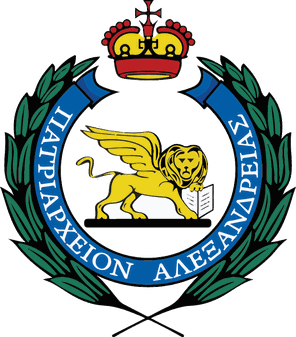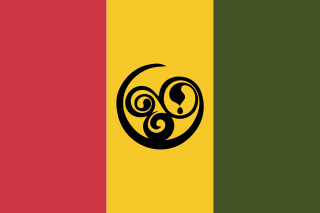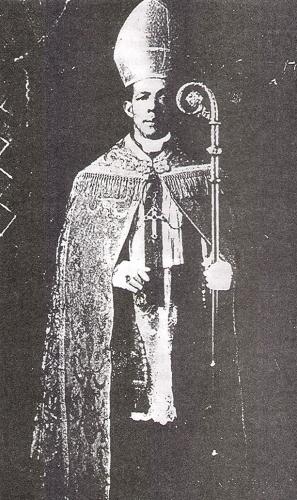
The Anglican Communion is the third largest Christian communion after the Roman Catholic and Eastern Orthodox churches. Founded in 1867 in London, the communion has more than 85 million members within the Church of England and other autocephalous national and regional churches in full communion. The traditional origins of Anglican doctrine are summarised in the Thirty-nine Articles (1571). The archbishop of Canterbury in England acts as a focus of unity, recognised as primus inter pares, but does not exercise authority in Anglican provinces outside of the Church of England. Most, but not all, member churches of the communion are the historic national or regional Anglican churches.

An episcopal polity is a hierarchical form of church governance in which the chief local authorities are called bishops. The word "bishop" here is derived via the British Latin and Vulgar Latin term *ebiscopus/*biscopus, from the Ancient Greek ἐπίσκοπος epískopos meaning "overseer". It is the structure used by many of the major Christian Churches and denominations, such as the Catholic, Eastern Orthodox, Oriental Orthodox, Church of the East, Anglican, Lutheran and Methodist churches or denominations, and other churches founded independently from these lineages.

Lunenburg is a port town on the South Shore of Nova Scotia, Canada. Founded in 1753, the town was one of the first British attempts to settle Protestants in Nova Scotia.

The Ethiopian Orthodox Tewahedo Church is the largest of the Oriental Orthodox Churches. One of the few Christian churches in sub-Saharan Africa originating before European colonization of the continent, the Ethiopian Orthodox Tewahedo Church dates back to the acceptance of Christianity by the Kingdom of Aksum in 330, and has between 36 million and 51 million adherents in Ethiopia. It is a founding member of the World Council of Churches. The Ethiopian Orthodox Tewahedo Church is in communion with the other Oriental Orthodox churches.

The North End of Halifax is a neighbourhood of Halifax, Nova Scotia occupying the northern part of Halifax Peninsula immediately north of Downtown Halifax.

St. Mary's Cathedral Basilica is a Gothic Revival Catholic cathedral located in the downtown core of Halifax, Nova Scotia, Canada. It is the cathedral of the Archdiocese of Halifax-Yarmouth and is the largest Catholic church in the Archdiocese. Consecrated on October 19, 1899, it was made a basilica in 1950 by Pope Pius XII. The St. Mary's Cathedral Basilica boasts the tallest granite spire in North America.
The Evangelical Orthodox Church (EOC), founded on January 15, 1979, is an Eastern Protestant Christian denomination established by former leaders of Campus Crusade for Christ, who, reacting against the Jesus People movement, developed their own synthesis of Evangelicalism, Eastern Orthodoxy, and Shepherding Movement principles.
Mayann Elizabeth Francis, is a human rights advocate and public servant who served as the 31st Lieutenant Governor of the Canadian province of Nova Scotia.

St. Paul's Church is an evangelical Anglican church in downtown Halifax, Nova Scotia, within the Diocese of Nova Scotia and Prince Edward Island of the Anglican Church of Canada. It is located at the south end of the Grand Parade, an open square in downtown Halifax with Halifax City Hall at the northern end.

The Greek OrthodoxPatriarchate of Alexandria and all Africa, also known as the Greek Orthodox Church of Alexandria, is an autocephalous patriarchate that is part of the Eastern Orthodox Church. Its seat is in Alexandria and it has canonical responsibility for the entire African continent.
Whitney Pier is an urban neighbourhood in Sydney, Nova Scotia, Canada. Prior to the 20th century, this area was known as “Eastmount” or “South Sydney Harbour,” and had long been a fishing and farming district. It is a triangle-shaped area North of the Muggah Creek estuary running along the Eastern shore of Sydney Harbour.

The immigration of the Copts to Canada might have started as early as the late 1950s. Due to an increasing amount of discrimination towards Copts in Egypt in the 1970s and low income in Egypt. Canada has been receiving a greater number of these immigrants, and the number of Coptic immigrants into Canada has been growing ever since.

Black Nova Scotians are an ethnic group consisting of Black Canadians whose ancestors primarily date back to the Colonial United States as slaves or freemen, later arriving in Nova Scotia, Canada, during the 18th and early 19th centuries. As of the 2021 Census of Canada, 28,220 Black people live in Nova Scotia, most in Halifax. Since the 1950s, numerous Black Nova Scotians have migrated to Toronto for its larger range of opportunities. The first recorded free African person in Nova Scotia, Mathieu da Costa, a Mikmaq interpreter, was recorded among the founders of Port Royal in 1604. West Africans escaped slavery by coming to Nova Scotia in early British and French Colonies in the 17th and 18th centuries. Many came as enslaved people, primarily from the French West Indies to Nova Scotia during the founding of Louisbourg. The second major migration of people to Nova Scotia happened following the American Revolution, when the British evacuated thousands of slaves who had fled to their lines during the war. They were given freedom by the Crown if they joined British lines, and some 3,000 African Americans were resettled in Nova Scotia after the war, where they were known as Black Loyalists. There was also the forced migration of the Jamaican Maroons in 1796, although the British supported the desire of a third of the Loyalists and nearly all of the Maroons to establish Freetown in Sierra Leone four years later, where they formed the Sierra Leone Creole ethnic identity.
The timeline of Eastern Orthodoxy in North America represents a timeline of the historical development of religious communities, institutions and organizations of Eastern Orthodox Christianity in North America.

The Saint Sava Serbian Orthodox Monastery and School of Theology in Libertyville, Illinois is a monastery and professional theological school in the Serbian Orthodox Church in the USA and Canada. The school is a collocated facility with the monastery.

George Alexander McGuire was the founder of the African Orthodox Church, and a prominent member of Marcus Garvey's Universal Negro Improvement Association (UNIA).
St. Philip's may refer to:

The Saint Sava Serbian Orthodox Church is a Serbian Orthodox church in Jackson, California. Built in 1894, the church was the first Serbian Orthodox church in America. Amador County had a large Serbian-American population in the late 1800s due to the California Gold Rush, and the county's Serbs established the St. Sava Church Organization of Amador County in 1886–87; the organization was responsible for purchasing land for and building the church, and the effort was led by Sevastijan Dabović. The church's original design had an Eastern Orthodox influence, complete with an onion dome; while the dome was later replaced by a bell tower, the church's stained glass windows and use of icons still give it a distinctive Eastern Orthodox character. The church has been used for Serbian-American religious and social activities since its opening and is now part of the Serbian Orthodox Eparchy of Western America.

The Little Dutch (Deutsch) Church is the second-oldest building in Halifax, Nova Scotia, Canada, after St. Paul's Church. It was built for the Foreign Protestants, and is the oldest site in Canada associated with Lutheranism. It is a National Historic Site of Canada.















